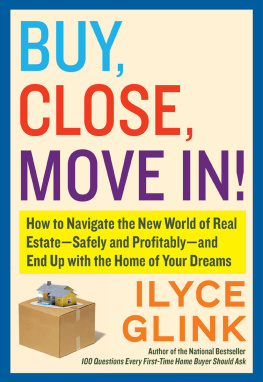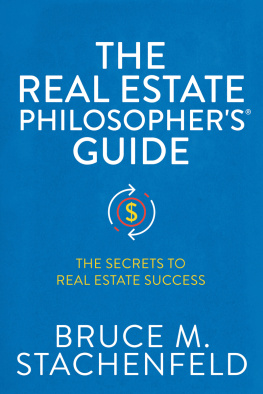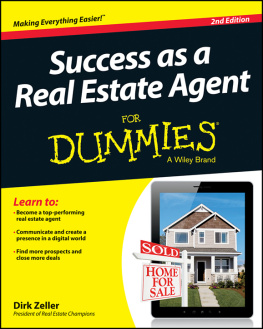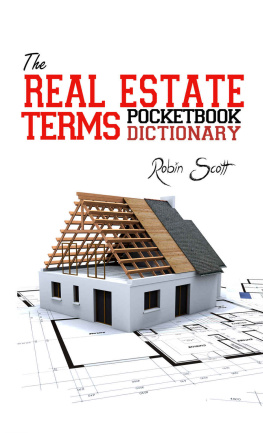For Sam, Alex, and Michael,
without whom my home would be just a house.
As a financial journalist covering the residential real estate market, I have always been determined to stay up to date on the latest rule changes and the hottest technical innovations. The last thirty-six months have made that a challenge. They have proven to be some of the toughest in my twenty-odd years covering the wacky world of real estate.
It isnt just that rules have changed. The culture of residential real estate has shifted completely. Since 1994, when the first edition of my book 100 Questions Every First-Time Home Buyer Should Ask was published, buyers and sellers have become increasingly savvy and sophisticated. It is possible for todays home buyer to know almost as much about a neighborhoods demographics, home sales, and trends as the most informed real estate agent. The Internet has revolutionized how the real estate industry functions day to day, and the buyernot the seller or the agenthas become the center of the transaction.
The only thing a buyer doesnt have is the wisdom that experience brings to temper the zeal and outsized emotions that come with making the single biggest purchase of your life. For that reason, I still believe home buyers can benefit enormously from using a top-notch real estate agent to help them buy a new or an existing home.
Technology, the 2008 credit crisis, and the greater know-how of buyers, homeowners, and sellers continue to affect and change the U.S. real estate market. This book will help you identify some of the new trends and big changes youll confront as you buy, own, rent, and sell real estate over the next few years.
Be sure to check out my Web site, ThinkGlink.com, for updates, news, and information. Sign up for my free weekly newsletter, follow me on Twitter (@Glink), check out my YouTube channel (YouTube.com/expertrealestatetips) and connect to my Facebook page (Facebook.com/IlyceGlinkFanPage) to stay on top of this changing universe. If youd like to share your real estate successes or if you have a question that confounds you along the way, please feel free to e-mail me at Ilyce@thinkglink.com.
I LYCE R. G LINK
January, 2010
W hen I started writing about real estate in 1988, local newspapers had fat weekend sections filled with ads for new-construction developments, housing listed for sale by real estate agents, mortgages that carried interest rates upward of 10 percent, and homes that were for sale by owner (FSBOs).
At that time, I wrote freelance stories for the local papers about Chicago-area developers who were gobbling up huge tracts of farmland and dividing them into subdivisions with 200 to 400 units each. I wrote about hardscape (the roads, curbs, and other impermeable features of a subdivision landscape plan), the growing interest in maintenance-free communities (where you dont have to mow your own lawn and someone comes to fix the leaky roof), and the increasing variety of limited common elements (like jazzed-up clubhouses and community centers, swimming pools, and covered parking) that developers used to attract buyers. I also started writing about first-time home buyers and the process of buying a home.
In those days, the best and virtually the only way to get information about homes for sale was to make an appointment with a local Realtor (a member of the National Association of Realtors, or NAR). The agent had a thick book that looked like a telephone directory, with newsprint pages; inside were black-and-white photos of the fronts of houses, along with a few details of the listings: the address, price, property taxes, and size and number of rooms. There might also be space for a few words about the property, such as View of the lake or Seller motivated or Newer kitchen with gracious entertaining space. Information on how to contact the listing agent and on the commission split would be included as well.
The books were printed once every two weeks. If you were sneaky, you could swipe an old listing book to page through in secret at home. But no one could see you take it, or the Realtor would get in trouble for letting The Book get away.
Your only other option for getting more information about homes for sale was to drive around the neighborhood and look for For Sale signs.
Remembering this makes me laugh, because real estate agents and brokers have long seen themselves as the center of the real estate transaction, and clamping down on the listing book was their way of regulating information. I cant tell you how carefully and thoughtfully my husband, Sam, and I studied the six-week-old information in old listing books with my mother, Susanne Glink, a top Chicago real estate agent for more than twenty-five years, when we were looking for a home.
That was the old world of real estate, and it operated like that for decades. Until the early 1990s, there was no Internet, no Google, no Realtor.com (or other such listing search sites), no Bankrate.com, no Vacation Rentals by Owner (VRBO.com), no Trulia.com, no Craigslist, nor any of the other ways we connect today with information about home buying and selling.
In 1993, as my first book, 100 Questions Every First-Time Home Buyer Should Ask , was going to press, I got my first e-mail address, at AOL.com. By then, the real estate industry was also going onlinealthough, in some cases, it was dragged there, kicking and screaming.
From the mid-1990s through about 2007, the world of real estate became digitized:
 Listings went online, and Google and other search engines made it easier to find homes that were for sale.
Listings went online, and Google and other search engines made it easier to find homes that were for sale. More recent Internet technology allowed you to wander neighborhoods digitally and get at least a cursory view of whats next to, in front of, and behind a house youre thinking of buying.
More recent Internet technology allowed you to wander neighborhoods digitally and get at least a cursory view of whats next to, in front of, and behind a house youre thinking of buying. Images of homes for sale evolved from black-and-white to color to digital to 360-degree to interactive photos (in which you click on various points in the house to look at different vistas)and then to video of the house, property, and surrounding neighborhood.
Images of homes for sale evolved from black-and-white to color to digital to 360-degree to interactive photos (in which you click on various points in the house to look at different vistas)and then to video of the house, property, and surrounding neighborhood. Realtor.com became the national virtual warehouse of listings, but hundreds of thousands of real estate company and individual agent Web sites cropped up to help people find themand millions of homeowners set up their own Web sites. Technology giants like Google, Yahoo, and eBay started their own real estate listing sites, while smaller tech companies created Web applications, or apps, for various platforms as well as cell phones and smartphones.
Realtor.com became the national virtual warehouse of listings, but hundreds of thousands of real estate company and individual agent Web sites cropped up to help people find themand millions of homeowners set up their own Web sites. Technology giants like Google, Yahoo, and eBay started their own real estate listing sites, while smaller tech companies created Web applications, or apps, for various platforms as well as cell phones and smartphones. Silicon Valleybased technology companies joined with real estate companies to create mapping software, home valuation technology, real estate tax software, foreclosure listings sites, private label software, and mobile applications like SmarterAgent, which downloads listing information to any cell phone or smartphone and allows you to search for houses by ZIP code or by real estate company as you explore the area in which you want to buy.
Silicon Valleybased technology companies joined with real estate companies to create mapping software, home valuation technology, real estate tax software, foreclosure listings sites, private label software, and mobile applications like SmarterAgent, which downloads listing information to any cell phone or smartphone and allows you to search for houses by ZIP code or by real estate company as you explore the area in which you want to buy. Sites like Zillow.com and Trulia.com became top aggregators, mashing up real estate listings with mapping tools and Web 2.0 technologies to allow potential buyers to communicate with one another. These sites made it possible for you not only to find the home youre interested in buying but also to comment on it, locate neighborhood amenities (Where is the nearest Starbucks?), and figure out school district boundaries. At Zillow, you can get a Zestimate, its guess of how much the house is worth, and a number of other sites also provide home valuations. (My advice: Take these numbers with a grain or two of saltand perhaps an aspirin.)
Sites like Zillow.com and Trulia.com became top aggregators, mashing up real estate listings with mapping tools and Web 2.0 technologies to allow potential buyers to communicate with one another. These sites made it possible for you not only to find the home youre interested in buying but also to comment on it, locate neighborhood amenities (Where is the nearest Starbucks?), and figure out school district boundaries. At Zillow, you can get a Zestimate, its guess of how much the house is worth, and a number of other sites also provide home valuations. (My advice: Take these numbers with a grain or two of saltand perhaps an aspirin.)









 Listings went online, and Google and other search engines made it easier to find homes that were for sale.
Listings went online, and Google and other search engines made it easier to find homes that were for sale.